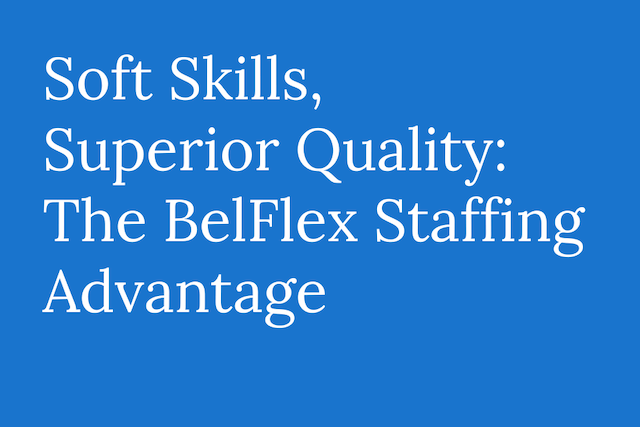Onboarding a New Hire: How to Create a Program that Works
In today’s challenging hiring landscape, employers must put their best foot forward.
From the job post itself, to the application and interview process, those responsible for filling roles need to make it easy and attractive for candidates to pursue open positions. But the work doesn’t stop there.
Once a candidate accepts an offer and becomes an employee, what happens next is just as important when it comes to retaining that employee and determining whether that new hire will recommend the company as a place to work.
The same way it’s crucial to continue engaging new customers after they’ve made a purchase to ensure they remain customers, it’s crucial to meaningfully engage new employees once they sign on.
For us at BelFlex, this is where a comprehensive onboarding plan comes into play.
Why having a new hire onboarding plan matters
With turnover still high across many industries, and talent shortages persisting, we’re seeing that being able to attract AND retain employees is more important than ever.
Here at BelFlex, we understand that an important part of retention is ensuring new employees have a good experience with a company from day one (or even before day one). Consider this: employees who had a negative new hire onboard experience are twice as likely to look for new opportunities in the near future.
That’s not good news, given that only 12% of employees strongly feel that their company does an excellent job of onboarding. With all the time, effort, and capital that goes into finding and hiring the right talent, no employer can afford to drive away good employees with a bad onboarding experience.
The quality of the experience can have a significant impact on staffing levels, and even workforce efficiency—a solid onboarding program can boost retention rate by 82% and employee productivity by 72%.
From our perspective, whether new hires view their new job and company favorably, and ultimately decide to stay or go, rests on the events of those first hours, days and weeks.
Top challenges in creating an onboarding plan
With so much importance resting on the employee onboarding process, why do so many organizations struggle with creating an effective onboarding plan or simply not have a plan at all?
These are common challenges we’ve seen both employers and employees face during the onboarding journey:
Employer challenges
- Owning the responsibility. Internally, there can be a lack of role clarity around who is responsible for creating an onboarding plan and executing it with a new hire. Whether it’s one person who leads that charge, or a team of people who each handle different aspects, it must be clear who is supposed to interact with the new hire and in what way.
- Embracing change management. Onboarding procedures realistically fall under a larger change management umbrella. But many companies do not even have change management protocols in place, let alone new hire processes that extend from them.
- Finding the time. Even when there is a process and role clarity around new hire onboarding, those responsible for handling it often struggle to find the time. Manager availability may be limited due to meetings and travel, while others may have sudden project emergencies pop up. The best laid plans often don’t pan out.
- Information overload. There’s a tendency to want to throw everything and the kitchen sink at a new hire. This can overwhelm the new employee and create record-keeping chaos for HR and other internal team members. Or, the opposite can happen. Not enough information is shared, or technology access isn’t set up. This is where a pre-hire plan can work wonders.
- Antiquated onboarding notions. Some organizations follow the “this is how we do it because it’s always been done this way” process. But given how much the working world has changed in just the last few years, everything from what a new hire needs to sign, to the tools they need to get up and running, is different. Onboarding programs must reflect this.
Employee challenges
- Paperwork paralysis. Anyone who has ever started a new job knows how much paperwork is involved. For many new hires, though, it gets thrown at them all at once. Having so much to print out, wade through, and send back can be overwhelming, especially if there’s not a clear process around when things are due and who must receive them.
- The “now what” question. More often than companies would like to admit, new hires start their employment journey without a clear idea of their roles and responsibilities, or the roles and responsibilities of their teams and others within the organization. If someone cannot clearly spell out what the new hire should be doing, the employee gets frustrated and their productivity suffers.
- Brain drain. Not enough information is bad. Too much information can be much worse. Having an unmanageable amount of information shared all at once—about the company, the culture, procedures, projects, benefits and operations—can have new hires feeling like they already have to play catch up, and can lead to misunderstandings or unrealistic expectations.
- Tech disconnect. Waiting until day one to think about the technologies, platforms, apps and equipment a new hire needs to do their job successfully is already a day too late. When a new hire shows up for work and doesn’t have the right tech, or has access to it but isn’t trained on it, it sets them up for a frustrating experience that can last days or even weeks.
- Finding a helper. Without a clear onboarding process, a new hire often doesn’t know who to turn to for questions or help. This wastes their valuable time and sends the message that they aren’t important enough for someone to ensure they have the level of support and connection they need to do their best.
6 tips Belflex follows to create an onboarding plan that works
When it comes down to it, the biggest roadblock to successful onboarding is getting employers and new hires to participate.
These six actions, which we’ve put into practice ourselves, can help you overcome that hurdle and get you on the road to achieving a better onboarding process:
- Send out a welcome kit. Before day one, send out a packet that includes a welcome message and company-branded swag to help them feel more connected to the organization and their team from the start. Do this whether the new hire will ultimately be onsite or remote, and include a quick overview of what they can expect over the next days and weeks. This is considered pre-hire onboarding, and it accelerates getting new hires up and running.
- Create a comprehensive plan. Map exactly what forms to fill out when, and what training will be needed on which dates. For example, schedule I-9 and tax form completion pre-start date, and day one can be a team welcome and filling out a few other forms, day two can have a 30-minute training on an important system, day three can be when the new hire watches videos about the company and their role, etc. Space it out and give the new hire time to breathe. Also, block time on their calendars for training and meetings over the first month, so new hires don’t feel pressured to “find time” once they are busier. A clear outline of contacts and a calendar of touchpoints is also important.
- Use the buddy system. Having a co-worker or team member assigned as a mentor or buddy can go a long way toward making a new hire feel less confused and more confident in their new role. A work buddy could show them the ropes about the company in general and, if they’re on the same team, the work duties, processes, and procedures involved in day-to-day operations. They can also help answer random questions, give them someone to take a break with, and make what can be a daunting first week seem less lonely and overwhelming.
- Be transparent about company culture. Being open and upfront about the culture of the company from day one will go a long way toward building new hire trust. Highlight programs that exist which can help them address their work or personal needs, including DEI initiatives, to give them a greater sense of community and connection to the organization.
- Spotlight financial awareness. Financial awareness is a hot topic for all workers, but especially for hourly employees. Consider implementing programs like early wage access, where employees can receive earned wages before payday. This eliminates the need for them to turn to title loan companies to borrow money, and helps them be secure in knowing they can address unexpected expenses in between paychecks. New hires will look at this, and other financial awareness efforts and offerings, as a highly positive part of working for the company.
- Create a follow-up plan. Designing an onboarding plan is important. Creating a plan to follow up with the new hire after initial onboarding is complete is equally important. It’s the only way to gauge if what you’re doing is effective and helpful for new employees, or whether you need to tweak procedures to create a better experience. In this vein, put together an onboarding survey that you send to every new hire within a month of their first day. Use what you learn to evolve your processes and make it even easier when the next new hire starts.
Reap the benefits of an effective onboarding plan
New employees who go through a structured onboarding program are 58% more likely to be with the organization after three years. That’s a promising retention rate, and a reason that investing in a better onboarding program is definitely worth the effort.
In addition, organizations who design an effective onboarding plan also create an environment where greater job satisfaction, improved employee productivity, stronger team connections, higher employee confidence, better knowledge retention, and elevated employee engagement can occur. This has been our experience at BelFlex.
Now is the time to take another look at your process for onboarding new hires and determine what opportunities for improvement exist. After all, the hiring landscape is competitive and challenging enough without losing hard-earned new hires for a reason that could have been prevented. The tips we’ve just shared are a good place to start, but you can reach out to us anytime to find out how we can help you achieve your staffing goals before, during, and after onboarding occurs.







